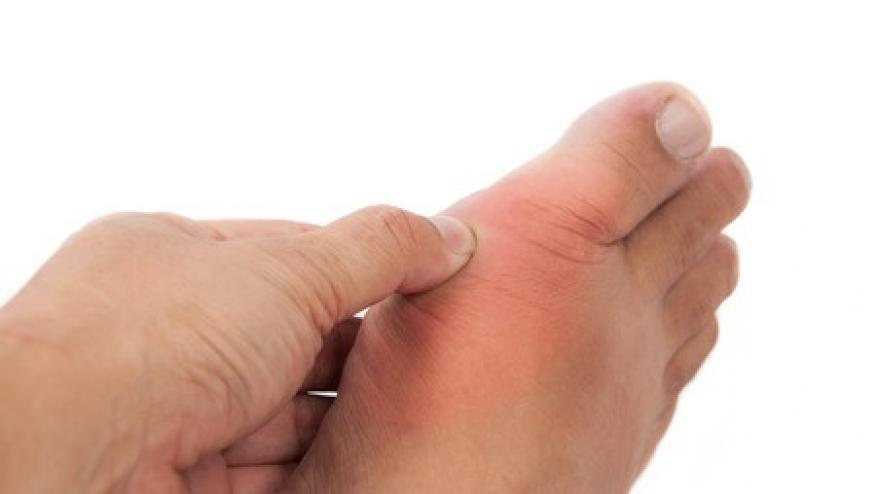ANAGO Study - Anakinra for Gout Flare Save

The interleukin (IL)-1 receptor antagonist anakinra (Kineret) was not superior to triamcinolone for relieving gout flares, but had similar effects for pain reduction as the glucocorticoid, a randomized phase II study found.
The mean change from baseline to 24-72 hours in pain intensity on a 0-100 scale was -41.2 (95% CI -46.3 to -36.2) for anakinra and -39.4 (95% CI -46.8 to -32) for triamcinolone, for a nonsignificant treatment difference of -1.8 (95% CI -10.8 to 7.1, P=0.688), according to Kenneth G. Saag, MD, of the University of Alabama at Birmingham, and colleagues.
But on several secondary endpoints such as patient and physician assessments of global response, anakinra was preferred. "Consistent with current treatment guidelines, anakinra can be considered as an effective option in the treatment of gout flares when conventional therapy is unsuitable," the investigators wrote online in Arthritis & Rheumatology.
Conventional treatments for gout flares include glucocorticoids, colchicine, and nonsteroidal anti-inflammatory drugs (NSAIDs), but comorbidities -- such as heart disease, diabetes, and kidney disease -- that are common among gout patients can make these treatments inappropriate. In addition, some patients with gout have flares that are refractory to these therapies.
Previous work has demonstrated efficacy for an IL-1 β monoclonal antibody, canakinumab (Ilaris), and a blinded non-inferiority trial comparing anakinra to the free choice of naproxen, prednisone, or colchicine also showed efficacy for IL-1 inhibition for acute gout flares.
To further explore the potential role for anakinra, Saag and colleagues undertook an adequately powered trial that compared intramuscular triamcinolone (40 mg) with two different dosages of anakinra (100 or 200 mg) for 5 days. The primary endpoint was change from baseline in patient-reported pain intensity, averaged from assessments at 24, 48, and 72 hours. Permitted rescue medications included acetaminophen, tramadol, and prednisone.
Of the 165 participants, median age was 55, 87% were men, mean disease duration was 8.7 years, and the mean number of flares in the previous year was 4.5.
Urate-lowering therapy was being used in 45% of patients in both anakinra and triamcinolone groups, and half of patients had three or more comorbidities. All were considered unsuitable for NSAID treatment, most often because of a lack of efficacy.
Similar efficacy was seen for the two anakinra dosing regimens, with change in pain intensity being -41.8 (95% CI -48.9 to -34.8) for the 100-mg dose and -40.7 (95% CI -47.9 to -33.4) for the 200-mg dose. "Therefore, the lower dose appears to be the clinically appropriate choice for treatment of a gout flare," the investigators noted.
Median time to resolution of pain was 120.5 hours for anakinra and 167.5 hours for triamcinolone, which was not a significant difference, and similar numbers of patients used rescue medications.
Significantly greater benefits for anakinra were observed in several secondary outcomes, including patient assessment of global response at day 8 (-0.63, 95% CI -1.03 to -0.22) and day 15 (-0.44, 95% CI -0.86 to -0.02), and physician assessment of global response at day 8 (-0.40, 95% CI -0.78 to -0.02).
The anakinra group also had significantly less tenderness (-0.47, 95% CI -0.73 to -0.20) and swelling (-0.31, 95% CI -0.56 to -0.05) at 72 hours, and greater reductions in C-reactive protein levels at 72 hours (-0.93, 95% CI -1.58 to -0.29) and at day 8 (-0.55, 95% CI -1.05 to -0.04).
During median extended follow-up of 62.4 weeks, 161 patients experienced a single flare, 61 had two flares, and 31 had three flares. Overall, there were 301 flares, with one patient reporting nine.
Mean reductions for pain intensity were similar for second flares, although for third flares triamcinolone was superior. However, the numbers for the third flare were small, at 26 in the anakinra group and only five in the triamcinolone group.
Adverse event incidence was similar in the anakinra and triamcinolone groups, with no unexpected signals. Hypertriglyceridemia developed in five patients on anakinra and neutropenia in four, while headache was reported in two patients on triamcinolone. Serious adverse events were reported in five patients; these included gastric ulcer, respiratory failure, and coronary artery disease and all were considered unrelated to treatment.
Anti-drug antibodies were present at low titers at some point in follow-up in 17.8% of patients receiving anakinra, and were detected at baseline in 6.5%. Neutralizing antibodies were present in 3.7%, which was similar to what has been seen for anakinra in other indications.
Although anakinra was not found to be superior to triamcinolone, it does have advantages, according to Saag and colleagues. "In contrast to glucocorticoids and/or NSAIDs, anakinra has not been reported to exacerbate diabetes, or promote hypertension, renal failure, sodium retention, gastric ulcerogenesis, or myocardial infarction," they noted. In addition, colchicine requires careful dosing in certain patients, such as those with kidney disease.
A potential limitation of the study was its use of pain response as the primary endpoint. Recent thinking about gout has suggested that a composite endpoint that included other clinical aspects of disease, such as swelling and immobility, might have been more appropriate, according to the investigators.







If you are a health practitioner, you may Login/Register to comment.
Due to the nature of these comment forums, only health practitioners are allowed to comment at this time.